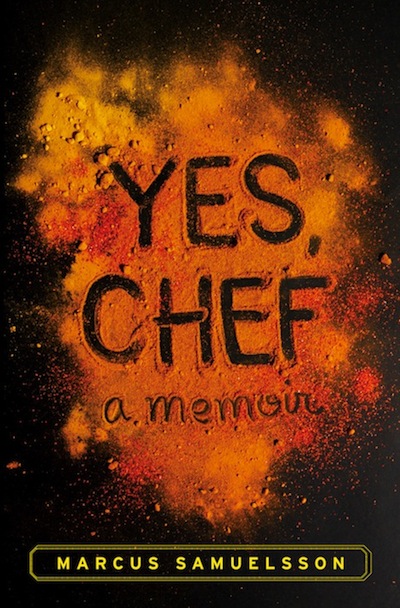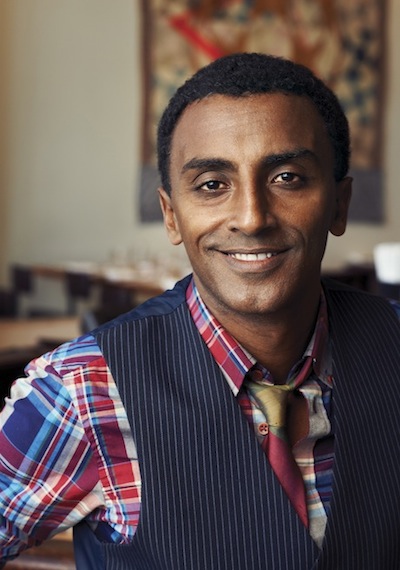
Marcus Samuelsson, photo credit: Kwaku Alston
His summer working aboard a Norwegian cruise ship was life-changing for Samuelsson as he visited ports of call from Venezuela to Saint Petersburg, always in search of new flavors. He writes passionately of the inspiration he got from tasting local street food: Jamaican grilled fish, Puerto Rican camarones de mofongo and Mexican tacos and how he kept a notebook with ideas for future dishes he might someday create. Aboard ship, he discovered other culinary traditions. “Norwegians were at the top of the heap, and the Filipinos who cleaned and actually ran the boat were at the bottom,” writes Samuelsson, who even though he was black was considered European. The staff mess hall had two menus: one for the Europeans, one for the Filipinos. But Samuelsson always ordered the latter and thus discovered chicken adobo and beef morcon.
Although, he had traveled the world, Samuelsson recounts the moment his plane touched down in New Yorks’s JFK airport, “First thing I noticed was all the black people…second thing I noticed that no one was looking at me differently. No, scratch that: No one was looking at me at all. Right then, I knew I’d come to the right place.”
He came to apprentice at New York’s Aquavit in 1994, and by 1995 was its executive chef and the youngest person to win a 3-star rating from the New York Times. In his work at Aquavit, he incorporated the notes he had taken during his travels. “I wanted to find ways to incorporate the efficiencies of Switzerland, the soulfulness of Austria, the reverence for ingredients I learned in France but I wanted to do it with a Swedish accent.”
In 1999, while still working at Aquavit, Samuelsson got an invitation to return to Ethiopia for an article for Gourmet Magazine. There, he met his father and 18 siblings for the first time. He eloquently describes how fell he in love with Ethiopian cuisine, especially its signature berbere spice blend. “It was both masculine and feminine, shouting for attention and whispering at me to come closer.”
In 2010 he opened his Harlem restaurant Red Rooster. “I wanted Red Rooster to guard the history of black cooks in America while starting new conversations in food. [My mission] “as a black chef is clear: to document, to preserve, to capture, to inspire and to aspire.” Even though he acknowledges that he is a European immigrant when it comes to racial history, during the 15 years he’s lived in the U.S., he has developed several theories about why kitchens of major American restaurants remain so white, including: The Nest Egg Theory and The I Didn’t Iron Clothes So You Could Flip Burgers Theory.
Samuelsson’s desire to share his good fortune is evident throughout the book. Since he personally struggled with racism as a black chef, Samuelsson is more open to giving people a chance to prove themselves. In 2000, he met Michael Garrett, who is now his executive chef at Red Rooster. Garrett presented himself as a line cook with two restaurants on his resume, Houlihans and Olive Garden. Samuelsson immediately gave him a job at one of his restaurants when he knew that other chefs wouldn’t have even let him in the door. He explains, “It’s not just that I believe in food that is global. I believe there’s a door that opens from inside any great kitchen, a door that opens out and gives us the world.”
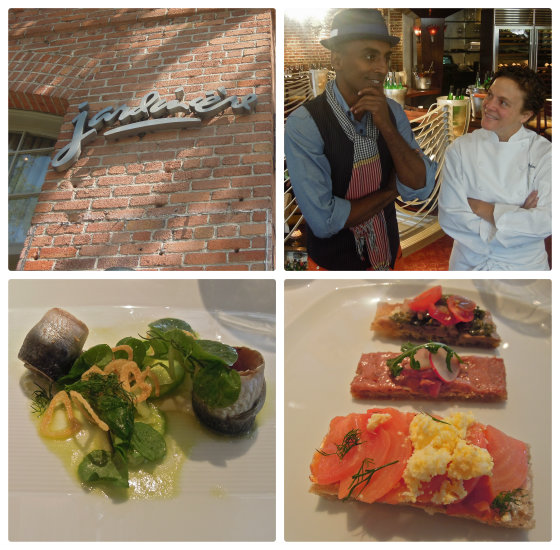
Marcus Samuelsson and Traci des Jardins at the Scandinavian lunch in his honor at Jardinière
Bay Area Bites caught up with Samuelsson at Jardinière last Thursday, where Traci des Jardins’ staff delighted him by preparing a Scandinavian lunch, including roll mops with cured local sardines and cucumber dill salad and a smørrebrød trio. Three open faced strips of rye bread topped with veal tongue and tomatoes, salmon, beets and egg and duck liver pate with radishes.
Samuelsson, with an impish smile to match his colorful outfit (orange pants, navy pinstripe vest, checkered scarf and jaunty blue fedora) charmed fans by autographing copies of his book, visiting tables and chatting amiably with diners. After lunch he made a few remarks and answered questions. Highlights: “The kitchen is the new living room.” “What is my favorite kitchen tool? A fish spatula.” And, (unfortunately), “no plans to open a Bay Area restaurant.”
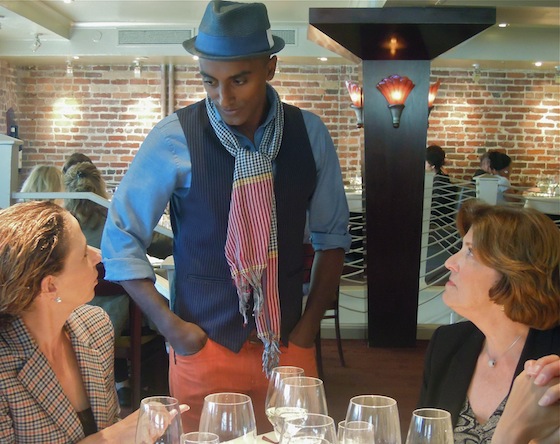
In an interview before last week’s lunch at Jardinière, Samuelsson answered BAB’s range of questions, on being an immigrant, developing his fried chicken recipe, eating with the hands and food bloggers. His comments have been edited for clarity and brevity. (Three of his signature recipes follow.)
You describe Sweden as a total knife and fork culture. In Ethiopia, by contrast, food is served family-style and eaten with the hands. Since you are connected to both cultures, do you feel more like a knife and fork person or a hand person?
I’m definitely a hand person. When you eat with your hands, it requires other things of you. You eat cleaner. With the ritual, you wash your hands more, then dry them on the towel offered to you. It becomes dining on a different level.
At Red Rooster we serve cornbread that people eat with their hands, of course. We also have a lot of communal dishes -- like uptown chowder, for 6-8 people to share. It’s about breaking bread together as a concept. It could be with a knife and fork. It could be eating with hands. To me, it’s about not being stuck in one narrative of dining, but being open to numerous ways.
What ingredient or spice is your favorite flavor of the moment?
I love berbere (recipe for the Ethiopian spice blend follows), because I learned so much about myself and my life through berbere. Before, it was just another great spice blend, but when I started to travel to Ethiopia and understood my own culture and its rituals, I started to really develop an appreciation for berbere. It is the salt and pepper of Ethiopia; you taste it in snacks, in bread, in spiced butter and cheese and of course over fish and meat.
You are passionate about chasing flavors and combining different elements from the various cultures that you have explored. Do you have advice for home cooks on deepening or combining flavors?
The key is to be surrounded by diverse sets of people. Ask your friends and coworkers what to do with the pickles and spices from their parents’ or grandparents’ generation.
You have personal experience as an immigrant yourself, plus many of the people in the kitchens where you’ve worked have been recent immigrants as well. How would you describe an immigrant’s food journey -- is it about loss, finding comfort, adapting?
It could be different for an immigrant or a refugee. As an immigrant from an upper middle class Scandinavian country, I can go back four times a year if I really want a herring. It’s definitely a privilege, but the loss is still there. When I don’t get my smoked cod roe fix in the morning, I’m still mad. So as an immigrant, I miss my food from a privileged point of view.
Refugees have to fight in a different way, because they can’t go back. So a refugee has almost a spiritual context for their longing for a certain dish. As a refugee, it’s more hardcore. You cannot return. You eat something and feel the loss of your family; you eat something and feel the struggle that you had.
My naturalization ceremony was an incredible experience that I wish that every American who bashes their own country could see. As immigrants and refugees, we fight everything to become Americans. It was one of the biggest honors of my life. I shared the room with 250 other people who maybe had to escape through six countries before they came here, or had to hide for twenty years before they could even say that they are here. So that’s the reason a dish tastes yummy to that person; what they’re tasting is the 25 years of loss and journey. That makes the food incredibly delicious and very deep.
In your book, you had some strong words to say about food bloggers, “…who take the pulse of a restaurant every thirty seconds and sound a death knell if they don’t like the feel of a napkin.” What were you reacting to?
The majority of food bloggers I think are very good. With the democratization of dining, people will be engaged in many different ways. Twitter, The Chronicle, and radio are just alternate platforms. I’m fine with that as long as it is done with sincerity, care and respect for the place, because it took the person a long time to put it all together. But if it’s the opposite of that and bloggers want to trash the fact that you are kind and positive because it’s easier for them to get a click, then I don’t care for that. Because it’s the livelihood of not only the chefs and owners, it’s the busboy’s livelihood too. I can handle criticism. I come from the hospitality field where you train and you respect because hospitality is the highest art form of giving. I think that bloggers are fantastic…they just need to care as much as I would care about the blog they are putting out. Because you don’t just dismiss the big guy, you’re dismissing the dishwasher too.
Who are your favorite Bay Area chefs?
Russell Moore of Camino, who made a great African-inspired menu last night with a lot of soul and spirit.
Traci [des Jardins], I’ve known her for a long time and we cooked together 15 years ago. She represents ‘the other’ for me, not just being a male chef. As a member of a minority, you relate to anybody who is ‘other’ and you want that person to succeed. Alice [Waters] of course. It all started with Alice and Jonathan Waxman. My friend, Chris Cosentino. He’s always pushing it. I admire his guts. I have great respect for chef Gary Danko. One of my favorite restaurants in the country is The Slanted Door. Charles Phan opened the door for ethnic food with a wine list.
You wrote that coming up with a fried chicken recipe was daunting because you didn’t grow up eating it and so many people have made versions that are so good. How did you go about it?
By studying, eating a lot of it, taking my time, failing many times.
What were you aiming for?
Authorship, by combining respect for the past plus bringing a new nuance to it by curing the chicken the way my grandmother did, by marinating it in buttermilk and coconut milk, frying it on low heat with seasoned oil, using seasoned flour and finishing it off with a shake of a special spice blend.
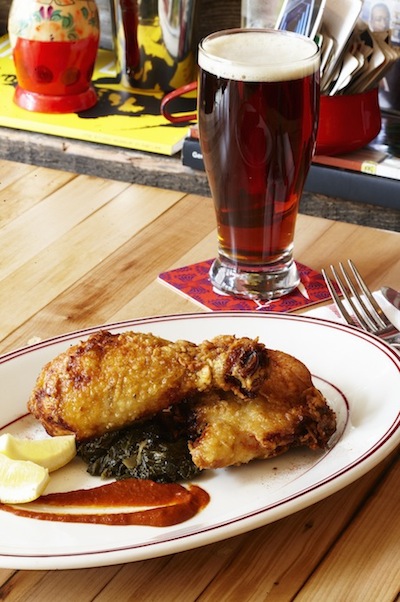
Red Rooster's "Fried Yardbird." Photo credit: Paul Brissman
Recipe: Marcus Samuelsson’s FRIED YARDBIRD
Serves: 4
Ingredients:
4 chicken thighs, skin-on
4 chicken drumsticks, skin-on
1 cup salt
8 cups water
1 quart buttermilk
3/4 cup coconut milk
2 garlic cloves, minced
1 tablespoon Chicken Shake (recipe below)
1/2 pound all-purpose flour
2 ounces semolina flour
1 ounce cornstarch
1/2 ounce ground white pepper
5 quarts frying oil
Directions:
1. Mix salt in water, until dissolved. Place chicken in brine and let sit for 1 1/2 hour.
2. Combine buttermilk, coconut milk, garlic and Chicken Shake then place chicken in marinade overnight in refrigerator.
3. Combine all-purpose flour, semolina flour, cornstarch and white pepper to make breading.
4. Remove marinating chicken from fridge and allow excess marinade to drip off.
5. Roll chicken in breading, shaking off excess.
6. In an 8-quart pot, fill with oil and bring to 300 F. Once oil is hot, drop chicken in to the oil and let fry for about 15 minutes (inner temperature should be at least 165 F).
7. Remove chicken from oil and place on paper towel. Season chicken with Shake, to taste.
Recipe: Chicken Shake
Makes: 4 cups
Ingredients:
1/8 cup ground garlic
1/2 cup celery salt
1/2 cup ground cumin
1 cup berbere (recipe follows)
1 cup smoked spicy paprika
1/8 cup kosher salt
1/2 cup ground white pepper
Directions:
Combine in a mixing bowl and stir until blended.
Recipe: Berbere spice blend
Prep Time: 10 mins
Cook Time: 5 mins
Total Time: 15 mins
Ingredients:
2 tsp. coriander seeds
1 tsp. fenugreek seeds
1/2 tsp. black peppercorns
1/4 tsp. whole allspice
6 white cardamom pods
4 whole cloves
1/2 cup dried onion flakes
5 dried chiles de árbol, stemmed, seeded,
and broken into small pieces
3 tbsp. paprika
2 tsp. kosher salt
1/2 tsp. ground nutmeg
1/2 tsp. ground ginger
1/2 tsp. ground cinnamon
Directions:
1. In a small skillet, combine coriander seeds, fenugreek seeds, black peppercorns, allspice, cardamom pods, and cloves. Toast spices over medium heat, swirling skillet constantly, until fragrant, about 4 minutes.
2. Let cool slightly; transfer to a spice grinder along with onion flakes and grind until fine. Add chilies, and grind with the other spices until fine.
3. Transfer the mixture to a bowl and stir in paprika, salt, nutmeg, ginger, and cinnamon. Store in an airtight container for up to 6 months.
